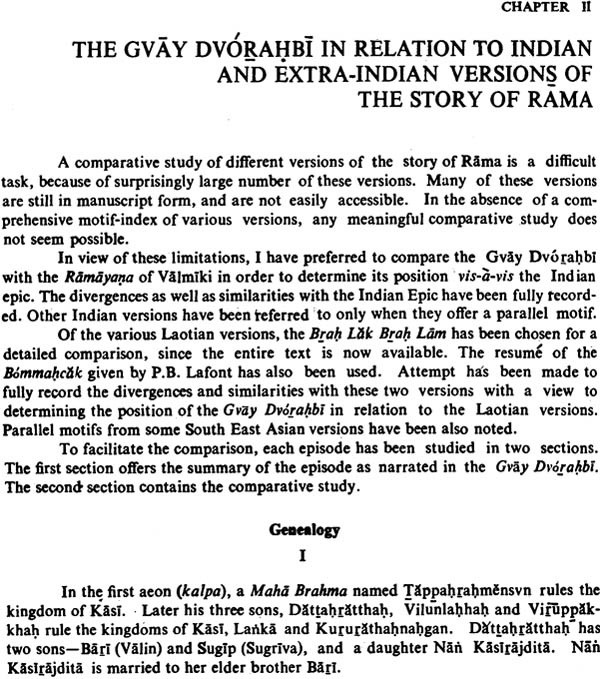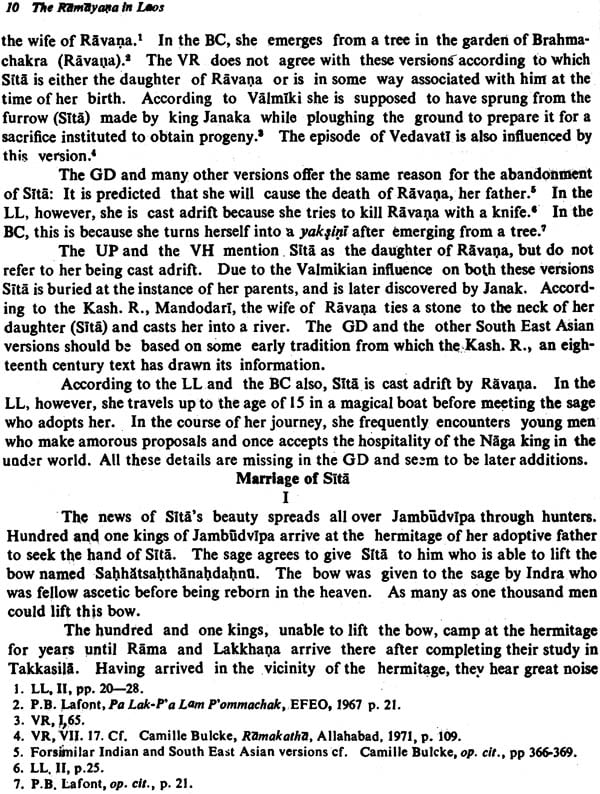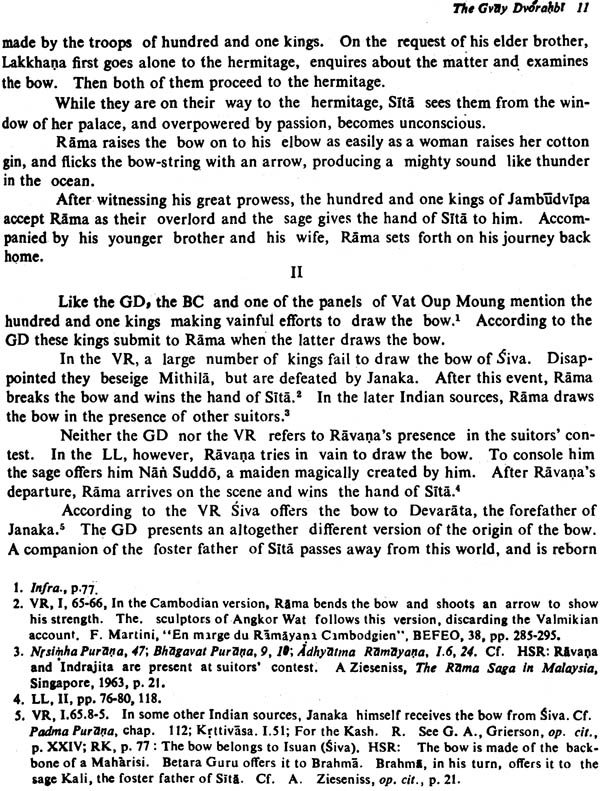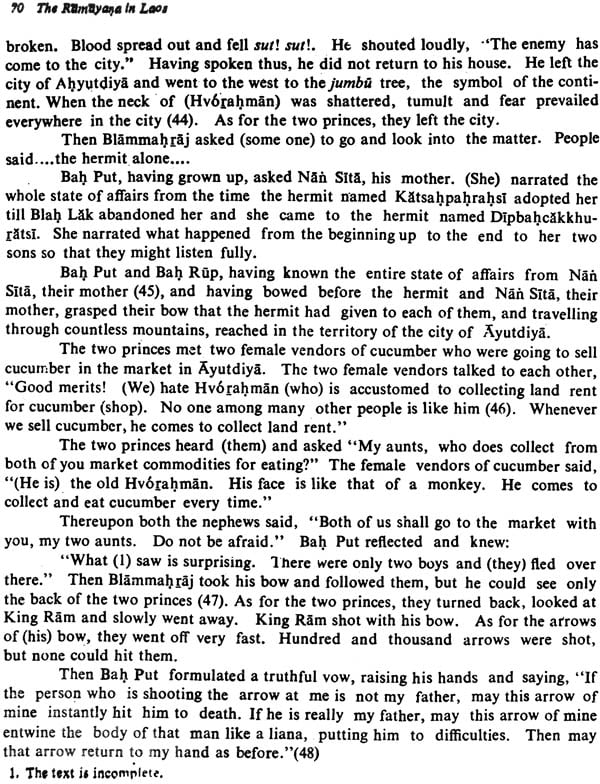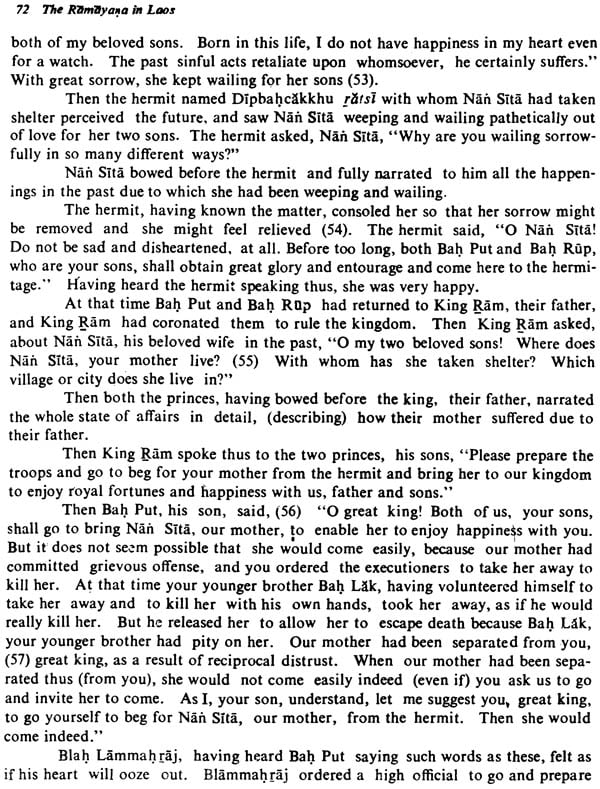
Lao Ramayana Gvay Dvorahbi (Rendering Into English from "Lav" Language)
Book Specification
| Item Code: | NAL443 |
| Author: | Sachchidanand Sahai |
| Publisher: | B.R. Publishing Corporation |
| Language: | English |
| Edition: | 2004 |
| ISBN: | 9788176464031 |
| Pages: | 168 ( 33 B/W Illustrations) |
| Cover: | Hardcover |
| Other Details | 10.0 inch x 6.5 inch |
| Weight | 460 gm |
Book Description
About the Book
The monograph offers a unique version of the Ramayana from Laos, considered as an “out-post” of Indian civilization in South-East Asia. The original palm leaf manuscript of the Gvay Dvorabhi which forms the basis of this study was preserved in the collection of the Royal Palace, Luang Prabang in 1970s. The title of the text pronounced as Khvay Thuaraphi, buffalo Dundabhi is a well-known character of the Valmiki Ramayana in its Kiskindha kanda. With this title, however, the whole story of the Ramayana has been narrated by the Laotian author.
In its introductory chapter, the reader rediscovers the interesting process of localization by which the events of the Ramayana have been placed in different parts of Laos.
This section also explores the elements of Laotian folklore integrated into the Ramayana story. The following chapter (II), critically compares Gvay Dvorahb with the Indian and extra Indian versions of the story of Rama.
Chapter III offers an annotated English translation of the Laotian text. Chapter IV comments on the mural paintings of Vat Oup-Moung in Vientiane, (Laos) which describes the story of Ramayana in 33 panels as known to the Laotian painter. These panels assume greater importance today as the edifice whose walls they adorned have been recently demolished in course of reinnovation of the monasteries.
Chapter V offers the text of the Gvay Dvorahb in the Laotian language and script as copied from the original Yuan manuscript by the scribes of the royal palace.
In an illuminating foreword, Professor Suniti Kumar Chatterjee, the renowned Indian linguist, highlights the importance of this Publication in the study of Ramayana and the culture of Laos.
About the Author
Professor Sachchidanand Sahai
(Born 1941) served as Pro-Vice Chancellor, Magadh University, Bodh-Gaya in 2001. Currently he is Member, Indian Council of Historical Research, New Delhi. Professor Sahai obtained his M.A. degree in Ancient Indian History, Culture and Archaeology from Banaras Hindu University, with the award of A.S. Altekar Gold Medal in 1962. His researches on ancient Cambodia under the guidance of eminent French savant George Coedes in the University of Paris (Sorbonne) during 1965-69 lead to a doctoral degree and the Publication of pioneering work Les institution politiques et I’ organisation administrative du Cambodge ancient, EFEO, Paris, 1971.
Professor Sahai was offered a Fulbright post-doctoral fellowship at Cornell University, Ithaca, New York, Visiting Fellowships at Australian National University and Maison de Science de I’ Homme, Paris.
Under the auspices of Indian Council for Cultural Relations Professor Sahai worked as Visiting Professor of Asian Civilization at Sisavangvong University, Vientiane, Laos. He also worked as Research Professor at Indira Gandhi National Centre for the Arts, New Delhi. Professor Sahai is the author of a number of books and research papers on the cultural history of South East Asia. He is the founder of the South East Asian Review. and the International Conference on Thai Studies.
Foreword
The Sanskrit Ramayana of Valmiki, which perhaps attained to something like its present form some time during the beginning of the Christian era, is unquestionably one of the greatest books of the world, and has been a work of paramount importance practically throughout the greater part of Asia. In modern Europe also the value of this work as the repository of a great historical or romantic saga, which has helped to build up the moral character of peoples among forty nations, has been universally admitted. The importance of the Ramayana in the national life of most of the peoples of Asia outside the Christian and Islamic worlds is acknowledged by everyone and a recent Ramayana Seminar held at Djakarta in Indonesia and at New Delhi in India testify to the value of the Ramayana as a great creation of literature. The Second International Seminar on the Ramayana held at New Delhi from the 7th to the 10th December 1975, which was attended by eminent scholars who have been working on the Ramayana in different languages not only in India but in the countries of Asia as well as in some of the European countries and also in America, created great enthusiasm, and the sixty and more scholars who took part in it all composed and read or delivered lectures on certain aspects of the Ramayana in various languages of the world. It was realise by the participants, in a way which was not appreciated before, how the Ramayana formed a sort of a National Epic for ever so many nations in their own languages-not only in Sanskrit and the ancient languages of India, but in all the various medieval and modern Indian languages as well as languages outside India like Indonesian in various forms, “Thai, Lao and other related languages, Cham, Khmer or Cambodian, Mon or Talaing, Burmese, Sinhalese, Chinese in its various forms, Korean, Japanese, Mongolian, Tibetan, old khotanese, etc. etc.”.
The basic story of Rama and his adventures as in the Sanskrit Ramayana of Valmiki has on the whole been retained intact. But in all the countries both in India and outside India, there have been a series of variation in the Rama story which gave us new versions or recensions in most of these languages. And these differ in some cases in certain fundamental matters from the Sanskrit version of valmiki. It is to be noted that within India itself there are other versions than that of Valmiki which give new topics and new situations in the story not found in Valmiki. This means that within India itself there were, in addition to the version presented by Valmiki. Other form of the Ramayana story which give the legend in different forms. The Ramayana story as current in various non-Indian languages becomes a subject of study of highest importance in Comparative Literature.
Among the various non-Indian versions of the Ramayana, the Indonesian and the Thai or Siamese have their own special importance, and they show certain characteristics which are well worth a study, to find out how and when these versions took their form. In that great book written in Hindi by the Belgian scholar in Ranchi, India, Father Camille Bulcke S.J., viz. “Rama-Katha”, we see the extent and variations of the Rama saga in its different versions in the various languages. A detailed study of the Indonesian and the Siamese versions of the Rama story for instance bring to us quite a mass of fresh material not known to the Sanskrit, and among these extra-Indian versions, the most aberrated and bizarre appears to be the version of the Ramayana as current in the country of the Lao in Indo-China.
There has been already some kind of study of the various versions of the Rama story in most of the countries India, and we have some very good works on the Indonesian Ramayana and the Thai Rama-kien (i.e.Rama-kirtti) in the Thai or Siamese language. Their contents and deviations from the Sanskrit Ramayana are well known. But the Lao Ramayana so far has remained not properly studied, although it was noticed by French scholars as early as 1932 (by Henri Deydier and others).
After the preliminary work of the French and Dutch scholars, the Rama story in Indo-China and Indonesia attracted the attention of some of the scholars from India. They have now taken to the Rama story as presented by the Indonesian and Indo-Chinese tradition, and the importance of this comparative study is now becoming very clear to us.
Preface
In 1972, I visited the Royal Palace, Luang Prabang, to collect materials for a critical edition of the Brah Lak Brah Lam, a project which I had undertaken under the auspices of the Indian Council for Cultural Relations, New Delhi. In the course of an audience graciously granted to me during this visit, His Majesty Sri Savang Vatthana, the king of Laos, observed: “Though the Brah Lak Bra Lam constitutes the most important Lao version of the Rama legend, a study of the theme cannot be complete without examining several minor versions of the story prevalent in Laos”. With His Majesty’s kind permission, a palm leaf manuscript of one such version entitled the Gvay Dvorahbi was loaned to me from the collection of the Royal Palace, Luang Palace, Luang Prabang.
The present volume offers for the first time this manuscript with a critical study and a translation of the text in English. Since the text of this manuscript was composed in Laos for off-set printing at a later stage, its translation could not be set facing each page of the text. However, each folio of the manuscript has been numbered in the text as well as in the translation by putting the numeral in bracket. The mural paintings of Vat Oup Moung have also been re-examined here since some significant points have escaped the notice of previous authors.
For the transliteration of Lao, the system proposed by P.B. Lafont has been adopted with minorModifications. However, common romanized spelling has been preferred for well-known place-names and ethnic names.
I express my grateful and warm thanks to Mr.A.S. Gonsalves, the then Indian Ambassador to Laos for supporting this project in every way. Thanks are due to Mr. Si Saveuy Souvanny and Mr. Khamphoumy Toui Sitthiphonxai for invaluable assistance give in the preparation of the press copy, and in the proof reading of the Lao text, and to Mr. Sombun khounsrivong for interpreting difficult passages and expressions. I am also deeply grateful to Mrs. Rosemary Borthwick for offering me meticulous and creative editorial assistance. In fact, without her erudite collaboration I would not have ventured to translate this text bearing so many serious lacunae and difficult passages. Finally, I wish to acknowledge my sincere gratitude to Professor Suniti Kumar Chatterji for his kindness in contributing a foreword to this monograph.
I naturally assume responsibility for errors that have slipped in this work past so many expert hands.
I hope this monograph will be useful to the scholars interested in the study of the extra-Indian versions of the Rama saga.
Introduction
The composition of the Ramayana by the celebrated Samskrta poet Valmiki marks the beginning of a continued process of literary creations in Samskrta, Pali, Prakrta, Apabhramsa and in several regional languages of India, which narrate the story of Rama in its various forms and versions. However, in spite of all efforts to record the prevalent versions of the story in some literary form or the other, several versions of the story continue to exist in oral and folklore traditions.
In addition to the Valmikian version of the story, many non-Valmikian versions travelled to South East Asia with the Indians of different origins and areas, who visited the region or settled there from time. The pioneering researches on the Rama saga in South East Asia have already revealed the existence of a surprising number of versions of the story in this region.
In Laos, which has rightly been described by Coedes as an “out-post” of Indian civilization, and where the story of Rama is prevalent in a number of versions as part of the living tradition, no attempt had been made to edit and Publish the text of these versions before I took up the editing of the Brah I a Brah Lam during the two and half years of my stay in Laos from 1971to1973. The manuscripts had lain undiscovered by the outside world in Buddhist monasteries of private homes and had at the mercy of copyists while being transmitted from generation to generation.
Laos has strangely remained an area of darkness for those scholars who have been interested in the study of cultural contacts between India and South East Asia. While scholars have already made some study of the Thai, the Burmese, the khmer, the Malay and the Indonesian version of the Rama story, the absence of such studies of the Lao versions can largely be explained by the fact that the first step of establishing the texts which would be the basis of these studies had yet not been taken.
Though considerably smaller than the Brah Lak Brch Lam, the text of the Gvay Dvorahbi offers new data for comparative study and constitutes an independent version of the story. It provides a unique example of adaptation of this Indian theme to local habits and mores.
Manuscript used for the present edition
The original palm leaf manuscript of the Gvay Dvorahbi preserved in the Royal place, Luang prabang, is written in the Yuan script and dialect and consists of two sections. This dialect is prevalent in the region of Xieng-Mai and in northern Laos.
The manuscript bears several lacunae and is copied in a confused and careless way. Nevertheless the story is quite clear in its general outline. The Royal Palace manuscript is the only copy so far known of the Gvay Dvorahbi. In the absence of parallel manuscripts, it was not possible to prepare a critical edition of the text.
The text of the present edition is not directly reproduced from the original Yuan manuscript, but from a Lao copy of the original inscribed on palm leaves by an erudite Lao scholar in the Royal Palace, Luang Prabang. The Lao copy was loaned to me with the assurance that it was prepared by a copyist of the Royal Palace, specially trained to reproduce the ancient manuscripts in their original form. In fact, the copyist of the Royal Palace has noted at the end of the text; “I finished the copying of the original text on the 30th May, 1971. Though the original manuscript carries many lacunae from page70 onwards, I have not added any.”
The original Yuan manuscript does not bear any date. However, the popular interpretation of some characters suggests that the Rama legend as presented by this manuscript should have been prevalent in the region of Xieng-Mai and northern Laos for many centuries before it was finally recorded in its present written form. According to the present version a child abandoned by Rabahnasvn was given the name of Sita because the sage Kassapa, after opening the golden casket in which she was concealed, found her rubbing (si) her eyes (ta) with her raised hands. Another example is the name of Ongot. He was named Ongot, as the text explains, because he was born with his limbs (on) curved (got), after his mother was wounded by the buffalo Dvorahbi.
Contents
| Foreword | ix | |
| Preface | xiii | |
| List of Illustrations | xv | |
| Abbreviations | xvii | |
| Transliteration | xix | |
| Chapter I: | Introduction | 1 |
| Manuscript used for the present edition | ||
| Title of the text | ||
| The Geographical setting of the story | ||
| Folklore in the story | ||
| Origin of the skirt (sin) | ||
| Horns of the buffalo | ||
| The Monkeys | ||
| The bat plays trick | ||
| Chapter II: | The Gvay Dvorahbi in Relation to Indian and Extra-Indian Versions of the story of Rama | 8 |
| Genealogy | ||
| Birth of Sita | ||
| Marriage of Sita | ||
| Abduction of Sita | ||
| Rama’s Meeting with Sita | ||
| Episode of the Buffalo Dvorahbi | ||
| Episode of Nandiyak | ||
| Birth of Hvorahman (Hanuman) | ||
| Hanuman Leaps Towards Sun | ||
| Rama Kills Valin | ||
| Hanuman in Search of Sita | ||
| Ongot’s Mission to Lanka | ||
| Construction of Rafts over the Ocean | ||
| Hanuman’s Relation with the Princess of the Under world | ||
| Banishment of Vibhisana | ||
| Abduction of Rama | ||
| Battle of Lanks | ||
| Exile of Sita | ||
| Birth and Adventures of Brah Put and Brah Rup | ||
| Conclusion | ||
| Chapter III: | The Gvay Dvorahbi: Translation | 34 |
| Section I | ||
| Section II | ||
| Chapter IV: | The Mural Paintings of vat oup-Moung | 75 |
| Plates | ||
| Chapter V: | The Gvay Dvorahbi: Text | 83 |
| Inscriptions of Vat oup Moung | 135 | |
| Dramatis Personae in the Gvay Dvorahbi | 139 | |
| Genealogical Table based on the Gvay Dvorahbi | 140 | |
| Select Bibliography | 141 | |
| Index | 145 |
